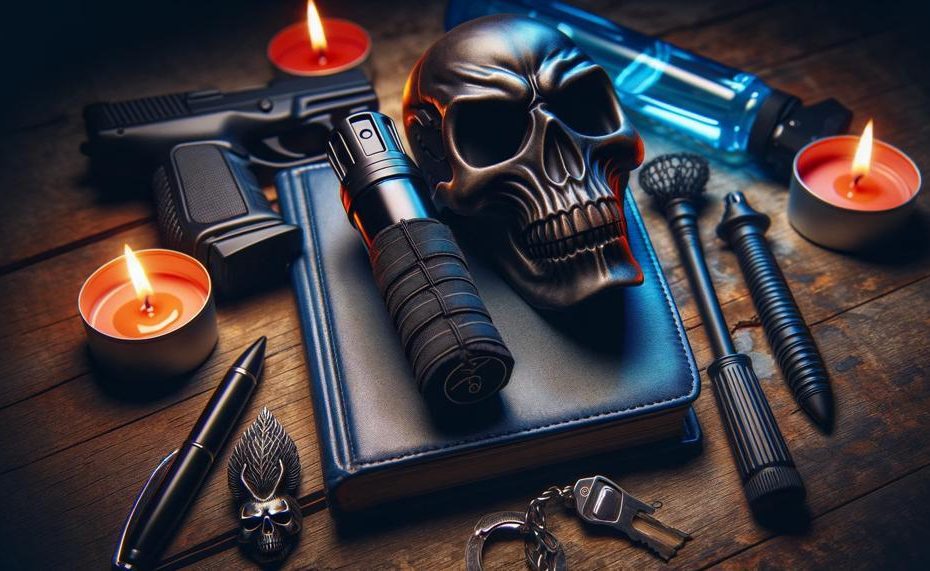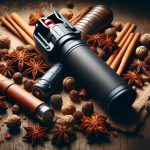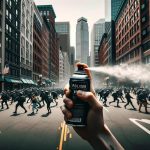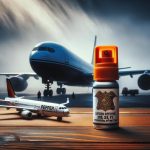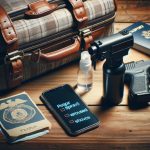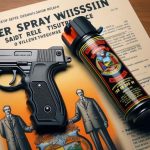Are you searching for a non-lethal self-defense solution that can effectively protect you from potential attackers? Look no further than pepper spray. This compact yet powerful spray has been a popular choice for personal protection for decades, and for good reason.
With its potent chemical compound and user-friendly design, pepper spray has proven to be a highly effective means of deterring and incapacitating assailants. But don’t just take our word for it – let’s explore the facts and discover why pepper spray is such an efficient self-defense tool.
Firstly, what exactly is pepper spray made of? It contains capsaicin, a natural chemical found in chili peppers that causes irritation and inflammation. When sprayed directly into the eyes, nose, or mouth of an attacker, this compound can cause intense burning pain, temporary blindness, and difficulty breathing. In other words, it packs a powerful punch.
But that’s not all – here are some additional key points to consider when it comes to the effectiveness of pepper spray: it is compact and easily portable, making it convenient to carry with you at all times; it is legal in most states and does not require a permit to purchase or carry; and it is an affordable option compared to other self-defense tools such as tasers or firearms.
In this blog post, we will delve deeper into the science behind pepper spray’s effectiveness and provide tips on how to properly use it for maximum impact.
So, get ready to learn more about this mighty self-defense tool.
Contents
- 1 What Helps Pepper Spray?
- 2 Understanding Scoville Heat Units (SHU)
- 3 Choosing the Right SHU Level for Personal Defense
- 4 Effective Deployment Techniques for Maximum Impact
- 5 Proper Handling and Storage of Pepper Spray
- 6 Precautions to Take Before Deploying Pepper Spray
- 7 Training and Familiarization with Inert Sprays
- 8 Conclusion
What Helps Pepper Spray?
| I. | Choose an appropriate pepper spray with a suitable SHU rating for your intended use. |
| II. | Aim for the attacker’s face within the spray’s range of 6-12 feet to maximize its effectiveness. |
| III. | Hold the canister firmly and point the nozzle at eye level, ensuring a proper grip for precise and accurate aim. |
| IV. | Store the pepper spray properly in a cool, dry place, and be sure to check expiration dates regularly to ensure its potency. |
| V. | If possible, verbally warn the attacker before deploying the pepper spray, to potentially de-escalate the situation before it turns violent. |
| VI. | Practice using inert training sprays to become familiar with the process and prepare for real-life situations. |
It is crucial to recognize that pepper spray should only be utilized in situations where self-defense is necessary and justified. Use of pepper spray for any other purpose is strongly discouraged. Furthermore, receiving proper training from a professional can greatly enhance one’s ability to effectively use pepper spray as a self-defense tool.
By taking these factors and precautions into consideration, individuals can confidently rely on pepper spray as an effective means of self-protection.
Understanding Scoville Heat Units (SHU)
Pepper spray is a self-defense tool that uses a measurement scale called Scoville Heat Units (SHU) to determine the spiciness or heat level of chili peppers. On this scale, the spiciness of peppers ranges from 0 to millions, with higher numbers indicating hotter peppers. The SHU is an essential factor in determining the effectiveness of pepper spray as a self-defense tool.
The active ingredient in pepper spray is capsaicin, a chemical compound responsible for the intense burning sensation when it comes into contact with skin or eyes. The higher the SHU of the pepper used to make the spray, the more potent it is in causing discomfort and incapacitation.
Initially, the Scoville Organoleptic Test was used to measure SHU by diluting pepper mash with sugar water until no heat could be detected. However, this method has been replaced by High-Performance Liquid Chromatography (HPLC), which directly measures the amount of capsaicin present in the pepper and converts it back into SHU.
To put this into perspective, a cup of Carolina Reaper mash, known as one of the world’s hottest peppers, would require over 2 million cups of sugar water to dilute its spiciness to zero. This clearly demonstrates the power and effectiveness of pepper spray made from such peppers in deterring an attacker.
Choosing the Right SHU Level for Personal Defense
When it comes to self-defense, selecting the appropriate pepper spray with a high SHU level is essential. The Scoville Heat Units (SHU) measures the potency of pepper spray, determining its ability to cause pain and temporary blindness.
Pepper spray is derived from capsaicin, an active ingredient extracted from chili peppers. The higher the SHU level, the more effective the spray is in incapacitating an attacker.
| SHU Level Range | Effectiveness | Recommended for: |
| 2,000,000+ | Extremely potent | Law enforcement and military use |
| 500,000-2,000,000 | Very powerful | High-risk areas or dangerous occupations |
| 100,000-500,000 | Moderately effective | General personal defense |
| Under 100,000 | Less effective | Animal deterrent or low-risk areas |
While a high SHU level is crucial, other factors such as size and spray pattern should also be considered when choosing pepper spray for personal defense. Some popular options include POM White and Mean Green sprays.
These sprays have a high SHU level (up to 2 million) and additional features like a quick-release and safety lock to prevent accidental discharge. The Mean Green spray also includes green dye for identification purposes.
It’s important to note that laws regarding pepper spray vary by region, so it’s crucial to research and understand regulations before purchasing and carrying it. Proper use of pepper spray involves aiming for the attacker’s face, using short bursts, and quickly escaping the situation.
It should only be used as a self-defense tool, not as an offensive weapon. Pepper spray has a range of 10-12 feet and can incapacitate an attacker for up to 45 minutes.
Effective Deployment Techniques for Maximum Impact
Pepper spray is a potent tool for self-defense that can incapacitate an attacker, providing you with the opportunity to escape safely. To ensure maximum impact when deploying pepper spray, it is crucial to follow proper techniques, which include preparation, aiming, and timing. Let’s delve deeper into these techniques below.
Preparation
Being prepared when carrying pepper spray for self-defense is essential. This includes acquainting yourself with local laws and regulations to ensure that you are legally allowed to possess and use pepper spray in your vicinity.
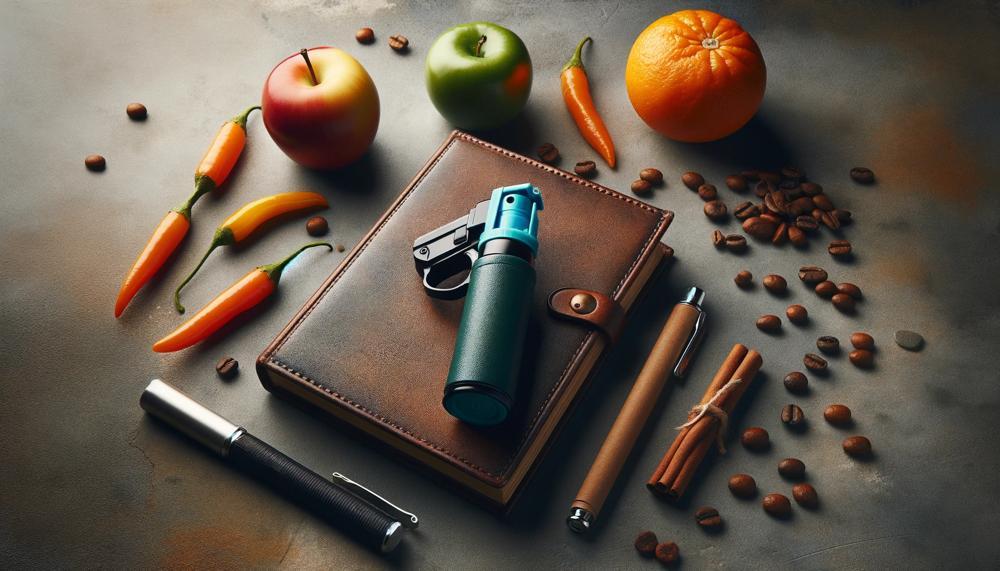
Moreover, keeping pepper spray in a holster or pocket makes it easily accessible in case of an emergency.
Aiming
When confronted by an assailant, always aim for their face when using pepper spray. This guarantees that the active ingredient, capsaicin, comes into contact with their eyes, causing temporary blindness and excruciating pain.
It is also imperative to maintain a safe distance from the attacker before deploying pepper spray.
Timing
Proper timing is crucial when using pepper spray for self-defense. It is advisable to use short bursts rather than continuously spraying the assailant. This not only conserves your pepper spray but also allows you to make a quick escape while the attacker is temporarily disabled.
Practicing good timing techniques will catch the attacker off guard and create distance between you and them.
Maintenance and Training
Regular maintenance and training are crucial to ensure the effectiveness of pepper spray. This includes checking the expiration date, as pepper spray can lose its potency over time.
Additionally, practicing using pepper spray in a safe environment can help you become more comfortable and confident in deploying it during a self-defense situation.
Proper Handling and Storage of Pepper Spray
Pepper spray, also known as Oleoresin Capsicum (OC), is a powerful self-defense tool made from chili peppers. Its ability to cause temporary blindness and extreme pain makes it an effective deterrent against potential attackers.
However, to ensure its reliability and effectiveness, proper handling and storage of pepper spray is crucial. Here are some best practices to follow when handling and storing pepper spray:
Select a Suitable Storage Container
When storing pepper spray at home, it is important to choose a container that can keep it secure and easily accessible. A designated drawer or cabinet, wall-mounted holder, or lockable container are all viable options.
For on-the-go situations, consider using a keychain canister or belt holster for quick access.
Regularly Check for Expiration Dates
It is recommended to check pepper spray every 3-6 months for expiration dates and potency, especially if you carry it with you daily.
Expired pepper spray should not be used as its potency may have significantly decreased.
Keep Away from Children
Pepper spray should always be kept out of reach of children. Accidental discharge can cause serious harm, so it’s important to educate children about the potential dangers of pepper spray and store it in a secure location.
Avoid Extreme Temperatures
Environmental factors such as heat, light, and moisture can degrade the OC over time, reducing its effectiveness.
Therefore, pepper spray should be stored in a cool, dry place away from direct sunlight or extreme temperatures.
Do Not Refill Canisters
Pepper spray canisters are designed for single-use only and should not be refilled. Using expired or refilled pepper spray can be dangerous and reduce its effectiveness.
Dispose of Properly
When disposing of pepper spray, it is important to follow local laws and guidelines for hazardous materials. Do not throw away a canister that still contains pepper spray, as it may cause harm to others.
Check with your local waste management or police department for proper disposal methods.
Precautions to Take Before Deploying Pepper Spray
Using pepper spray as a self-defense tool can be beneficial, but it is essential to take proper precautions before deploying it. These precautions include ensuring the legality of pepper spray in your state, selecting a high-quality product with a strong percentage of OC, and attending a training course to learn its proper usage.
It is also crucial to store and dispose of pepper spray correctly for optimal reliability and effectiveness. In this section, we will delve into these precautions in detail.
- Ensuring Legality: Before purchasing or carrying pepper spray for self-defense, it is crucial to check your state’s laws regarding its legality. While pepper spray is generally legal in most states, some may have specific regulations and restrictions on its use and possession. For instance, certain states may require a permit or limit the size and potency of pepper spray allowed.
- Choosing a Quality Product: Selecting a reliable and effective pepper spray product is crucial for self-defense purposes. Look for a product with a high percentage of OC (oleoresin capsicum), the active ingredient that causes irritation and temporary blindness. Additionally, consider the size of the canister and whether it has safety features to prevent accidental discharge.
- Training: It is highly recommended to attend a training course from a professional before using pepper spray in a self-defense situation. This not only teaches you how to properly use the product but also educates you on when and how to use it in a justified manner.
- Proper Storage and Disposal: Pepper spray should be stored in a cool, dry place away from children and extreme temperatures. It should also not be refilled or used past its expiration date. When disposing of an expired or damaged canister, make sure to follow local regulations as it can be harmful to the environment.
- Other Precautions: Pepper spray should only be used for self-defense or during an arrest if necessary and justified. It should not be deployed inside a moving vehicle as it can affect the driver’s ability to operate the vehicle safely. Additionally, try to avoid isolated or dangerous areas where you may feel the need to use pepper spray as a precaution.
| Precaution | Description |
|---|---|
| Ensuring Legality | Check your state’s laws regarding the legality of pepper spray for self-defense before purchasing or carrying it. |
| Choosing a Quality Product | Select a reliable and effective pepper spray product with a high percentage of OC and consider its size and safety features. |
| Training | Attend a training course from a professional to learn how to properly use pepper spray. |
| Proper Storage and Disposal | Store pepper spray in a cool, dry place away from children and dispose of it according to local regulations when expired or damaged. |
Training and Familiarization with Inert Sprays
As stated earlier, before utilizing pepper spray as a means of self-defense, it is imperative to attend a training course. This training involves exposure to inert sprays, which are non-toxic versions of pepper spray.
Here, we will delve into how training and familiarization with inert sprays can enhance the use of pepper spray as a self-defense tool.
Understanding the Effects of Pepper Spray:
Individuals in the military are frequently required to operate under pressure and in uncomfortable situations. Therefore, it is crucial for them to comprehend the effects of pepper spray and how to manage them.
Exposure to inert sprays during training provides first-hand experience and knowledge of the effects of pepper spray. This allows military personnel to develop a sense of respect for its potency and understand the significance of utilizing it only when necessary.
Building Trust in Equipment:
Apart from understanding the effects of pepper spray, training with inert sprays also assists military personnel in developing trust in their equipment. For instance, during training, soldiers must wear gas masks while being exposed to inert sprays.
This teaches them to have faith in their equipment and use it effectively in real-life situations.
Preparing for Worst-Case Scenarios:
Training with inert sprays also prepares military personnel for worst-case scenarios where they may unintentionally come into contact with pepper spray.
This includes learning how to function despite being exposed to the effects of pepper spray, such as closing their eyes, coughing, and tearing up.
Conclusion:
In conclusion, training and familiarization with inert sprays play a critical role in using pepper spray as a self-defense tool. It not only helps military personnel understand the effects of pepper spray but also prepares them for worst-case scenarios and instills trust in their equipment.
As a result, military personnel can effectively utilize pepper spray as a means of self-defense when necessary.
Conclusion
Pepper spray is undoubtedly a formidable non-lethal self-defense solution that has stood the test of time. Its compact and easy-to-use design, combined with its powerful chemical compound, make it a highly effective means of deterring and incapacitating attackers.
The natural capsaicin ingredient and high SHU level in pepper spray can inflict intense pain and temporary blindness on an assailant, giving you the opportunity to escape safely.
However, it is crucial to familiarize yourself with the laws and regulations governing its use and to receive proper training in deployment techniques.
By following these guidelines and taking necessary precautions, individuals can confidently rely on pepper spray as a potent tool for personal protection.
It’s important to remember that self-defense should always be a last resort, and avoiding conflict is always the best option. So stay safe, stay prepared, and consider adding pepper spray to your personal defense arsenal.
After all, it’s better to have it and not need it than to need it and not have it. Let this powerful self-defense tool give you peace of mind knowing that you have a reliable means of protection at your disposal.
